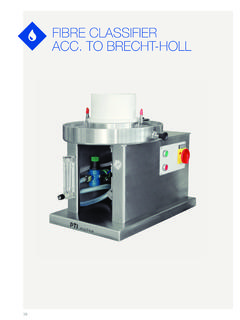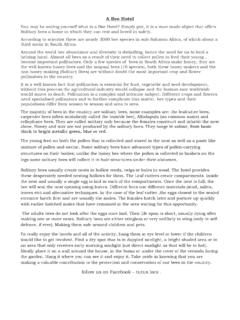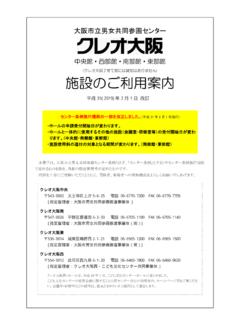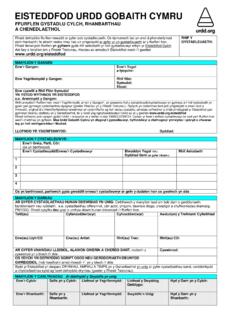Transcription of The Prevalence, Severity, and Distribution of Childhood ...
1 The Prevalence, Severity, and Distribution of Childhood food allergy in the United States Ruchi S. Gupta, Elizabeth E. Springston, Manoj R. Warrier, Bridget Smith, Rajesh Kumar, Jacqueline Pongracic and Jane L. Holl Pediatrics; originally published online June 20, 2011;. DOI: The online version of this article, along with updated information and services, is located on the World Wide Web at: PEDIATRICS is the official journal of the American Academy of Pediatrics. A monthly publication, it has been published continuously since 1948. PEDIATRICS is owned, published, and trademarked by the American Academy of Pediatrics, 141 Northwest Point Boulevard, Elk Grove Village, Illinois, 60007. Copyright 2011 by the American Academy of Pediatrics. All rights reserved. Print ISSN: 0031-4005. Online ISSN: 1098-4275. Downloaded from by guest on February 12, 2013. ARTICLES. The Prevalence, Severity, and Distribution of Childhood food allergy in the United States AUTHORS: Ruchi S.
2 Gupta, MD, MPH,a,b,c Elizabeth E. WHAT'S KNOWN ON THIS SUBJECT: Estimates of food allergy in Springston, BA,a,b Manoj R. Warrier, MD,d,e Bridget Smith, the United States range from 2% to 8% but are limited by several PhD,f,g Rajesh Kumar, MD,b,c Jacqueline Pongracic, MD,c,h factors. Previous studies often relied on small samples, lacked and Jane L. Holl, MD, MPHa,c data on mode of diagnosis/reaction history, were not speci c to a Institute for Healthcare Studies and cDepartment of Pediatrics, children, or were limited in scope to a speci c allergen. Northwestern University Feinberg School of Medicine, Chicago, Illinois; bSmith Child Health Research Program and hDivision of WHAT THIS STUDY ADDS: This study includes a representative allergy and Immunology, Children's Memorial Hospital, Chicago, Illinois; dDivision of allergy and Immunology, St Louis University sample of US households to estimate the overall prevalence of School of Medicine, St Louis, Missouri; eAllergy, Asthma and food allergy as well as the prevalence of allergen-speci c and Sinus Care Center, St Louis, Missouri; fProgram in Health severe food allergy .
3 Data also provide a framework for Services Research, Loyola Stritch School of Medicine, Maywood, discussions of disparity and the Distribution of Childhood food Illinois; and gCenter for Management of Complex Chronic Care, Edward Hines Jr VA Hospital, Hines, Illinois allergy in the United States. KEY WORDS. food allergy , prevalence, morbidity, disparities, epidemiology ABBREVIATIONS. RDD random-digit-dialing CI con dence interval abstract Dr Gupta was responsible for the conception and design of the OBJECTIVE: The goal of this study was to better estimate the preva- study, oversaw data acquisition, analysis, and interpretation, lence and severity of Childhood food allergy in the United States. and participated in drafting and revision of the manuscript; Ms Springston participated in study design, was responsible for METHODS: A randomized, cross-sectional survey was administered data acquisition, provided support for data analysis and electronically to a representative sample of US households with chil- interpretation, and was responsible for drafting and revision of the manuscript; Dr Warrier participated in study design, dren from June 2009 to February 2010.
4 Eligible participants included provided support for data analysis, and interpretation, and adults (aged 18 years or older) able to complete the survey in Spanish provided critical revisions to the manuscript, Dr Smith or English who resided in a household with at least 1 child younger participated in study design, conducted data analysis, participated in data interpretation, and provided critical than 18 years. Data were adjusted using both base and poststrati ca- revisions to the manuscript; Dr Kumar consulted on study tion weights to account for potential biases from sampling design and design, contributed to interpretation of data, and provided nonresponse. Data were analyzed as weighted proportions to estimate critical revisions to the manuscript; and Drs Pongracic and Holl prevalence and severity of food allergy . Multiple logistic regression oversaw study design, contributed to interpretation of data, and provided critical revisions to the manuscript.
5 Models were constructed to identify characteristics signi cantly asso- ciated with outcomes. RESULTS: Data were collected for 40 104 children; incomplete re- Accepted for publication Apr 15, 2011 sponses for 1624 children were excluded, which yielded a nal sample Address correspondence to Ruchi S. Gupta, MD, MPH, Children's of 38 480. food allergy prevalence was (95% con dence interval Memorial Hospital, 2300 Children's Plaza, Box 157, Chicago, IL [CI]: ). Among children with food allergy , had a history of 60640. E-mail: severe reactions, and had multiple food allergies. Prevalence PEDIATRICS (ISSN Numbers: Print, 0031-4005; Online, 1098-4275). according to allergen among food -allergic children was highest for Copyright 2011 by the American Academy of Pediatrics peanut ( [95% CI: ]), followed by milk ( [95% CI: FINANCIAL DISCLOSURE: The authors have indicated they have ]) and shell sh ( [95% CI: ]). Odds of food no nancial relationships relevant to this article to disclose.
6 allergy were signi cantly associated with race, age, income, and geo- graphic region. Disparities in food allergy diagnosis according to race and income were observed. CONCLUSIONS: Findings suggest that the prevalence and severity of Childhood food allergy is greater than previously reported. Data sug- gest that disparities exist in the clinical diagnosis of disease. Pediatrics 2011;128:e9 e17. PEDIATRICS Volume 128, Number 1, July 2011 e9. Downloaded from by guest on February 12, 2013. Childhood food allergy is associated The extent to which food allergy affects derstandability and consistency of with impaired quality of life, limited so- children in the United States also re- response. cial interactions, and comorbid atopic mains unclear. Previous estimates of The survey was then programmed 6 Moreover, there is evi- prevalence have not considered the se- for electronic administration. Quality- dence that hospitalizations for anaphy- verity of disease.
7 Furthermore, the un- control testing was conducted to as- laxis have increased more than derlying pathophysiology of disease is sure that skip logic and randomization fourfold among young people, with varied, and clinical manifestations en- were met. A pretest of 30 interviews food -induced anaphylaxis being the compass a diverse spectrum of symp- was electronically administered to most common Negative out- On ingestion of an allergen, an verify survey functionality and under- comes are compounded by limited affected child may experience an immu- standability. The survey was subse- treatment options, the absence of a noglobulin E or non immunoglobulin quently nalized based on pretest cure, and the ubiquitous and often un- E-mediated reaction characterized by results. identi ed presence of allergenic foods symptoms ranging from mild pruritus The nal survey is available on request in social settings. As a result, food al- to delayed gastrointestinal symptoms and includes items assessing partici- lergy can have a profound social and to life-threatening anaphylaxis.
8 Pant report of a child's food allergies. psychological effect on the daily lives Questions were asked about the date The heterogeneity and limitations of of affected children and their families. of onset, method of diagnosis, and re- available data necessitate further Several studies have estimated child- analysis of all perceived food allergies action history for each reported aller- hood food allergy prevalence in the on a larger scale. In the study de- gen. Detailed demographic items were United States over the past 2 decades. scribed here, report of allergy , mode also included. (Sicherer8 has reviewed this topic of diagnosis, and reaction history were thoroughly.) A frequently cited statis- Study Participants collected from a population-based tic is 6% to 8% based on a 3-year study sample of nearly 40 000 US households Eligible participants included adults by Bock9 conducted in the early 1980s. with children to better estimate the (those aged 18 years or older) able to More recently, Liu et al reported a complete the survey in Spanish or Eng- prevalence, severity, and Distribution prevalence of among children lish who resided in US households with of Childhood food allergy in the United age 1 to 5 years using serologic data at least 1 child younger than 18 years.
9 States. for peanut, milk, and egg allergy from Participants were recruited using a the 2005 National Health and Nutrition METHODS dual-sample approach. A target of Examination Branum and Lu- 6100 participants was recruited from kacs3 reported a prevalence of A population-based, cross-sectional a Web-enabled panel that is a statisti- among children younger than 18 years survey was administered between cally representative sample of US. of age based on self-report of a food or June 2009 and February 2010 to a rep- households with children. This sample digestive allergy collected as part of resentative sample of US households included households recruited using the 2007 National Health Interview Sur- with children. The institutional review probability-based random-digit-dialing vey. Finally, a recent meta-analysis boards of Children's Memorial Hospi- (RDD) sampling that had or were pro- commissioned by the National Institute tal and Northwestern University ap- vided Internet connectivity to complete of allergy and Infectious Disease con- proved the study protocol.
10 Consent to the survey. An additional 33 900 partic- cluded that the prevalence of food al- participate was implicit in completion ipants were targeted from an online lergy among all age groups likely falls and return of the survey. sample of US households with children between 1% and10%.11,12 who had access to the Internet. Re- Survey Development and Design sponses from the Web-enabled panel Important insight has been gained by these past estimates, but the preva- The survey was developed by pediatri- were used to identify and correct for lence of Childhood food allergy has yet cians, pediatric allergists, and health sampling and nonsampling biases (see to be de nitively established. Previous services researchers, with support of Statistical Analysis ). studies are often limited by small sam- an expert panel comprising leaders in Participant recruitment and survey ple size, lack of data on mode of diag- the eld. Expert panel review and cog- administration were conducted by nosis and reaction history, are not spe- nitive interviews (N 10) were con- Knowledge Networks, a survey re- ci c to children, or are limited in scope ducted using the approach described search rm in Menlo Park, California.





